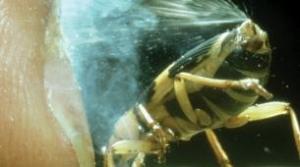Application of spray technology from Bombardier Beetle beetles
The bombardier beetle has inspired motor designers, designers of drug loading devices as well as fire extinguishers to improve spraying technologies.
Bombardier beetle bugs live mainly in Africa and Asia, especially in that it can spray a hot and toxic liquid against predators like birds or frogs. While the chemical reaction that creates venom has been confirmed for a long time, the true strength of the 20-centimeter-long spray of toxic chemicals is the cause for research.
The amount of hydroquinone and hydrogen peroxyt gas formed in the beetle's abdomen but when necessary to defend, they will mix together in a connected 'combustion chamber' to create toxic benzoquinone. This hot liquid is then fired with a strong force in front of the predator.

Bombardier beetle bugs live mainly in Africa and Asia, especially in that it can spray a hot and toxic liquid against predators like birds or frogs.(Photo: Institute of Physics)
The key to this bug's powerful defensive tip is the intake valve (or entrance) of the combustion chamber and the escape valves. The intake valve will open to receive the chemicals and will close when receiving the necessary amount of gas, which will heat up immediately upon contact with the valve.
When gases react to each other, they produce heat and increase pressure in the enclosed chamber. When this pressure reaches its peak, the end of the escape chamber is forced open and the hot liquid is ejected with a strong poison beam in a process known as 'rapid evaporation'.
Once the gas escapes, the outlet valve will close, the intake valve will open and the combustion chamber will be filled again, preparing for the next shot.
The research team at Leeds University's School of Material, Environment and Process Engineering has now recreated the way bombardier beetle is fired by hot poison. In a series of experiments using water (not using venom), McIntosh and his team could fire hot water rays up to four meters away and be able to adjust the size of water droplets in the beam. spray it. Currently, this technique has been licensed for industrial applications by Biomimetics 3000 Limited.
This new technology seems to be very interesting for companies in making drug delivery systems because it proves to be much more reputable than mechanical control technology, such as respiratory machines. The technology also provides a richer source of energy for fuel injection in car engines and even offers a new generation of fire extinguishers that can produce effective mist or droplets. Large water depends on the type of fire that needs to be extinguished.
Andy McIntosh of Leeds University and Novid Beheshti of Swedish company Biomimetics 3000 discussed the study in detail in the April issue of Physics World.
- This bug is truly the true
- 'Unveiled' beetle's secret
- Giant beetle 'compared to' emperor scorpions: Which species deserves the title?
- The beetle has a heart-shaped leg burning
- How is the beetle 'love' underwater?
- The assassin unleashes the beetle at mating
- The mysterious giant beetle
- Video: 'Terrible' beetles fight territory horns
- The vivid color of beetles can affect future light technology
- Dead bugs stuck in 99 million years of amber and pollen
- Mushrooms turn beetles into living corpses to lure prey
- You will fall back when you know the truth about this
 'Barefoot engineer' invents a pipeless pump
'Barefoot engineer' invents a pipeless pump Process of handling dead pigs due to disease
Process of handling dead pigs due to disease Radiometer
Radiometer Warp Engine: Technology brings us closer to the speed of light
Warp Engine: Technology brings us closer to the speed of light